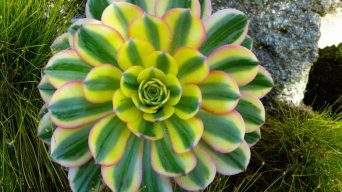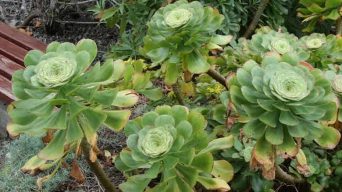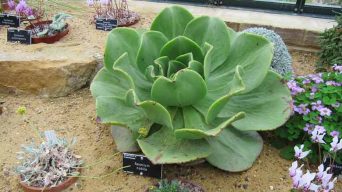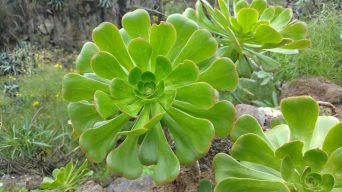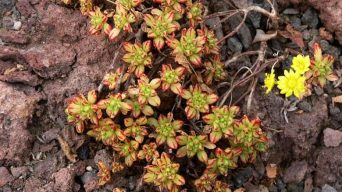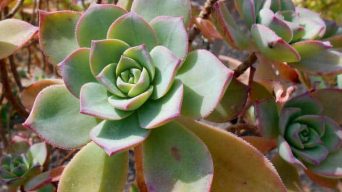If you are a gardener or a succulent lover, you have seen Aeonium tabuliforme plants.
They’re beautiful plants with unique shapes and patterns that can provide visual interest in any garden.
This Aeonium tabuliforme care and propagation guide will teach you how to take care of your succulents and propagate new plants!
Overview
| Family: | Crassulaceae |
| Genus: | Aeonium |
| Botanical Name: | Aeonium tabuliforme |
| Synonyms: | Aeonium berthelotianum, Aeonium macrolepum, Aeonium umbelliforme, Sempervivum complanatum, Sempervivum tabuliforme |
| Common Names: | Flat-Topped Aeonium, Dinner Plate Aeonium, Dinner Plate Plant, Saucer Plant |
| Origin: | Tenerife in the Canary Islands |
| USDA Hardiness Zones: | 9 – 11 |
| Size: | 2 inches (5 cm) high and up to 18 inches (45 cm) in diameter |
| Sun Exposure: | Full sun to partial shade |
| Water Needs: | Water thoroughly but infrequently |
| Soil Type: | Well-draining soil |
| Temperature: | 60° to 75˚F (18° – 23˚C) |
| Humidity Levels: | 30-40% |
Aeonium tabuliforme is a succulent species from the genus Aeonium in the family Crassulaceae found natively on the Canary Islands.
The Aeonium tabuliforme succulent plant grows to form a compact rosette of overlapping, nearly flat leaves.
The rosette of the Aeonium tabuliforme succulent plant starts narrow and typically only reaches about 2 inches (5 cm) high, but it can grow into a really wide circle up to 18 inches (45cm) in diameter.
Aeonium tabuliforme leaves are green and fleshy, with lengths up to 16 inches (about 15 cm) and widths up to 1.6 inches (4 cm) wide.
This Aeonium plant takes up to four years before it blooms. When the flower does appear, the raceme of yellow flowers can reach about 40-60 cm in height.
The Aeonium tabuliforme is a short-lived Aeonium species that typically die after flowering.
Some common names by which the Aeonium tabuliforme succulent is known are:
- Flat Topped Aeonium
- Dinner Plate Aeonium
- Dinner Plate Plant
- Saucer Plant
How To Care for Aeonium Tabuliforme
Aeonium tabuliforme care is a relatively straightforward process. Here are a few critical steps for your succulent plant to grow and thrive.
Below we explore how to take care of Aeonium tabuliforme succulent plants.
Sun Exposure & Light Requirements
Aeonium tabuliforme is a sun-loving plant, so direct sunlight is a must for it to thrive.
It should be kept in a bright and sunny spot indoors or outdoors if you live in a warm climate that doesn’t get too cold during the winter.
If grown indoors, keep your Aeonium tabuliforme near a bright and sunny window.
Regarding light intensity, aeonium tabuliforme should get a minimum of four hours of direct sunlight daily.
If you’re growing your Aeonium tabuliforme outdoors, ensure that the sun is not too intense during summertime. This may cause leaf scorching or sunburns.
Watering Requirements
Aeonium tabuliforme is a succulent plant that can be grown in various environments.
As long as the soil it’s planted in drains well, you should know how to water your aeonium plants properly.
Aeonium tabuliforme requires watering approximately once a week during the summer months and every two weeks during the winter months when rainfall is less frequent.
You want to avoid overwatering this succulent because they grow best with regular but infrequent irrigation sessions rather than soaking wet all the time.
The best way to know if a plant needs water is by checking for a waxy surface on top of the potting mix. If there’s no moisture, you need to water your Aeonium again soon!
If you overwater an Aeonium and its leaves start looking droopy or wrinkled, try letting the soil completely dry out before watering (usually two weeks).
Overwatering can quickly lead to rot for this succulent species, killing off any new growth.
Soil Requirements
The Aeonium tabuliforme plant requires well-drained soil, like a cactus and succulent mix.
The Aeonium needs well-drained soil because it can quickly rot due to the high moisture content of its leaves and flowers.
The best type of potting mix would be a succulent mix combined with a cactus blend, which will account for two kinds of plants’ specific requirements regarding water drainage.
As an option, you may also use regular potting soil mixed with about half perlite or coarse sand to keep the dirt loose and allow better drainage.
Temperature and Humidity
The Aeonium tabuliforme plant prefers a temperature between 60° and 75 °F. It cannot stand a temperature of less than 45 °F for a long time.
Do not expose your succulent to extreme heat or cold temperatures because they will damage your succulents and make them more prone to disease.
It prefers a slightly drier climate with a humidity level between 30% and 40%.
If there is high humidity or rainfall, ensure that you do not allow moisture to accumulate on the soil’s surface. This can cause rot, which could kill your succulent in severe cases.
Keep an eye out for any signs of leaf wilting as well!
Fertilizing
Aeonium tabuliforme plants require a low amount of fertilizer.
I recommend using a soluble, slow-release time-release type fertilizer diluted to ¼ strength every two weeks during the spring and summer months.
This is an excellent way to ensure that the plants get a sufficient amount of fertilizer without over-fertilizing.
Potting and Repotting
The Aeonium tabuliforme is a low-maintenance plant, so repotting Aeoniums every few years should be sufficient.
When it’s time to pot your Aeonium in a new container, you’ll want to consider the type of potting mix and soil you will use for this task.
When choosing a soil mixture, be sure it drains well, or water could pool around the area where roots meet the surface after watering.
You also need a pot with a drainage hole at the bottom to allow water to flow out of it.
The orientation of these holes in a container can also affect how quickly soil mix dries out and drains away from its roots. Be aware that this is something you should consider when looking for a new container.
Aeoniums do well planted directly into the ground or another appropriate growing medium without a container, as long as they are not too exposed to direct sunlight and have good air circulation.
Pruning
The Aeonium tabuliforme does not need a lot of pruning, but you should trim off any dead leaves or stems a few times a year.
If the plant has a problem with a stem that is not strong enough to hold itself up, it can be carefully cut away and will eventually grow new shoots in its place.
The Aeonium tabuliforme needs only minimal, light pruning once a year to maintain an attractive shape.
Pests and Diseases
There are a few pests and diseases to watch out for when growing Aeonium tabuliforme. Find out what they are and how to prevent or treat them.
Pests
Aeonium tabuliforme is susceptible to various pests, such as spider mites, mealybugs, and scale insects.
You can treat these pests with pesticides or natural treatments like horticultural oil spray and insecticidal soap.
Spider Mite Prevention
Spray the plant with water every few days, so leaves don’t get dusty.
Use a soft brush on any heavy dusting areas after spraying to prevent more damage from occurring.
Mealybug Treatment
Remove all affected rosette parts by hand (do not just cut them off) to stop the spread.
Apply a pesticide treatment containing pyrethrum or a neem oil-based product mixed with a carrier oil
Scale Insect Treatment
Remove any observable scale insects and administer a pesticide treatment that incorporates pyrethrum or a neem oil-infused product combined with a carrier oil.
Diseases
Aeonium tabuliforme can also be affected by various diseases, such as the corynespora leaf spot. It is characterized by black spots on the succulent leaves that eventually kill the plant if left unchecked.
You should treat this disease immediately; you can usually cure it through crop rotation for prevention purposes.
Other Aeonium tabuliforme diseases include achlya leaf spot, caused by a fungus that will form dark spots on the leaves with black dots.
You can also treat the achlya leaf spot through crop rotation for prevention purposes. It is most likely to occur when plants are too wet and humid.
Root rot is another disease that affects Aeonium tabuliforme succulent plant roots and usually occurs due to overwatering.
Leaf scorching may affect your Aeonium tabuliforme if you keep it outdoors during periods of intense sunlight.
This condition causes brown burn marks on the leaves, which can ultimately lead to the death of the plant.
How to Care for Aeonium Tabuliforme in Winter
Aeonium tabuliforme winter care includes protecting them from cold temperatures by placing them where they will receive a lot of light but are shielded from wind drafts.
Keep water from freezing inside their pots because it could break off roots when thawing during warmer weather.
When nighttime temperatures reach freezing, bring the container indoors or cover the exposed soil with pine needles or other mulch material so ice will not form a hard crust.
If a plant is in a pot you will not cover, remove it to a more protected location.
You can also create a protective cage around the base of your plants using chicken wire or other material to shield them from cold winter winds and provide additional insulation.
Do not fertilize during this time because you don’t want the roots to grow too fast when they thaw out in springtime.
How To Propagate Aeonium Tabuliforme
Aeonium tabuliforme can be propagated by seeds, leaf cuttings, and offsets.
Seeds
You should plant the Aeonium tabuliforme seeds about an inch deep into the ground for germination.
It would be best if you watered them gently until they have taken root well enough that you can pull your hand away without feeling any resistance.
The seeds usually take a few weeks to germinate. After a while, they should start popping up from the ground, with a rosette emerging from each one.
Once you see this happening, it’s time to water them again, but just gently so that they don’t rot because too much moisture can be as bad for succulents as not enough!
Aeonium tabuliforme also prefers soil that drains well without being overly dry. These plants are native to rocky slopes with little runoff or rainwater seepage.
Leaf Cuttings
One of the best ways to propagate aeonium tabuliforme is by taking a leaf cutting.
Most succulent plants, including Aeonium tabuliforme, form rosettes out of their leaves on a long stem that bends down with age.
You can take individual cuttings just below where this bend occurs and place them in potting soil after allowing the cuttings to callous for a few days.
Make sure you keep these moist but not soaking wet because they are sun-loving plants and need plenty of light!
You also want to avoid overwatering the plant while forming roots, so be attentive when watering your new baby succulent.
The most important thing to remember when propagating Aeonium tabuliforme is that it takes a while for the plant to take root and grow.
It’s important not to give up on your little seedling too soon, as a few weeks or one month. Your patience will usually be rewarded with a new precious addition!
Offsets
Aeonium tabuliforme offsets are a great way to propagate succulent plants.
You can either plant them in a pot or leave them as is and let the new baby aeonium grow independently, which it will eventually do if left unattended for a few months.
Offsets form when a mother plant sends roots into the ground that emerge with an individual rosette of leaves at their tips.
The offset should be planted about an inch deep into the soil and watered just enough so that there are no signs of wilting, but not too much water because these need plenty of sunlight!
Is the Aeonium Tabuliforme Toxic?
The Aeonium tabuliforme is not toxic, but it does have a sap that can cause skin rash in some people.
If this happens to you, try gentle scrubbing with soap and water before applying an antiseptic lotion or ointment.
Protective gloves should be worn whenever the plant touches your hands.
Final Thoughts
The Aeonium tabuliforme succulent plant is a low-maintenance, easy-to-care, and propagate.
It does not require much light or water as long as it has an excellent potting mix with good drainage and the soil isn’t allowed to dry out between watering sessions.
These succulents are very resilient plants that can tolerate various conditions.
However, they do best when given enough sun exposure but aren’t exposed to extreme heat from the sun for too many hours per day.
If Aeonium tabuliforme succulents are neglected or not given the proper care, they will lose their bright colors and become dull green.


